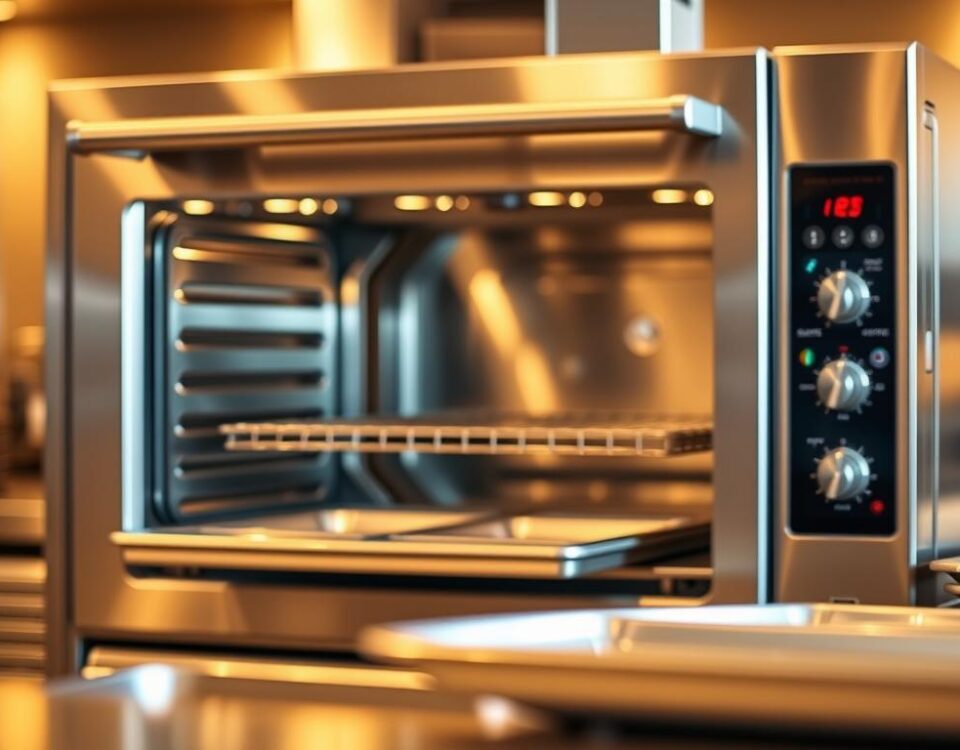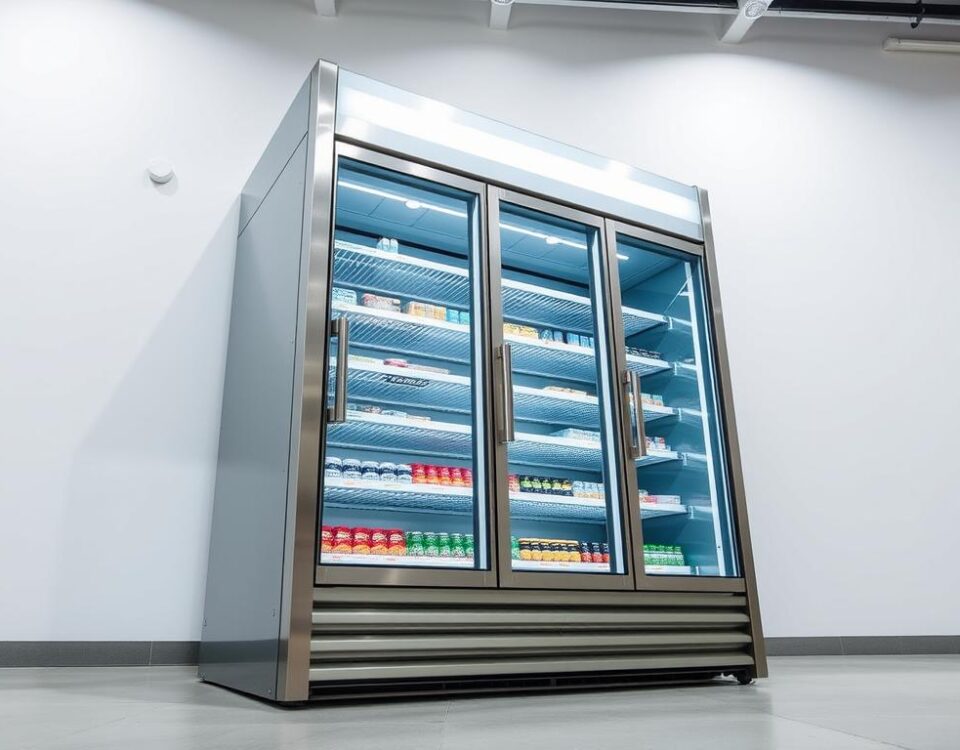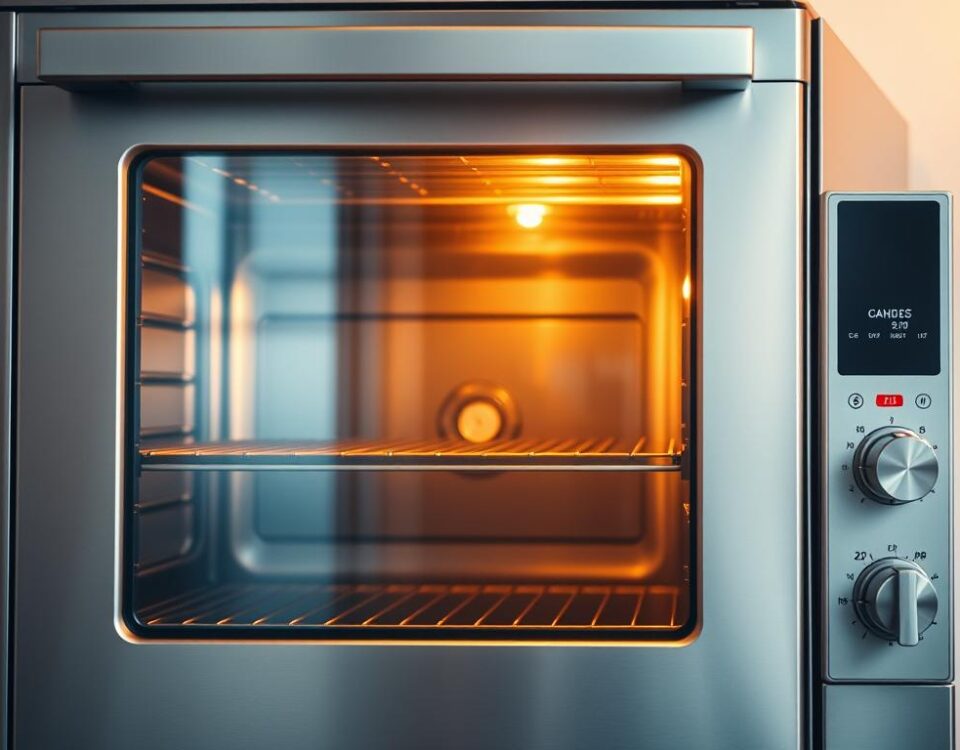
Quick Comparison: Buy True or Turbo Air in 2025?
September 21, 2025
I Tested 5 Units—The Best Commercial Convection Oven Revealed
September 22, 2025As a restaurant owner, you’ve likely experienced the frustration of having to discard spoiled food due to improper storage. I recall a situation where a busy kitchen staff forgot to adjust the temperature settings on their commercial refrigerator, resulting in a significant loss of perishable goods.
Did you know that the ideal temperature range for a refrigerator is between 34 and 40 degrees Fahrenheit? Maintaining this range is crucial for food safety and quality. Yet, many restaurants struggle with temperature control issues, leading to health code violations and unnecessary equipment repairs.
What if you could avoid these costly mistakes and ensure your kitchen is running smoothly? By understanding the common pitfalls in temperature management, you can protect your business reputation and bottom line.
Key Takeaways
- Understand the ideal temperature range for commercial refrigerators and freezers.
- Learn how to avoid common temperature control mistakes.
- Discover the importance of proper temperature management for food safety and quality.
- Find out how temperature fluctuations can impact your business profitability.
- Identify steps to improve your kitchen’s temperature control and reduce costs.
The Critical Impact of Temperature Control in Commercial Kitchens
Maintaining precise temperature control in commercial kitchens is crucial for food safety and quality. Temperature fluctuations can significantly reduce food shelf life and quality, making it essential to maintain consistent temperatures throughout refrigeration units.
Food Safety Regulations for Restaurant Refrigeration
Restaurants must follow specific food safety regulations regarding refrigeration temperatures, including health department requirements and industry standards. These regulations typically require refrigerators to be set at 40°F (4°C) or below, and freezers at 0°F (-18°C) or below.
How Temperature Fluctuations Affect Food Quality and Shelf Life
Even minor temperature fluctuations can dramatically reduce food shelf life, affecting everything from produce freshness to protein safety. For instance, a freezer that’s not maintaining a consistent temperature can cause ice crystals to form on frozen foods, leading to a decrease in quality.
| Food Category | Impact of Temperature Fluctuations |
|---|---|
| Produce | Reduced freshness and shelf life |
| Proteins | Increased risk of bacterial growth and contamination |
| Frozen Foods | Formation of ice crystals, affecting texture and quality |
Financial Consequences of Poor Temperature Management
Poor temperature management can lead to significant financial losses, including food waste costs, potential health code violation fines, and the expense of emergency refrigerator repairs. Inconsistent temperatures can also result in reduced equipment lifespan and increased energy consumption.
By maintaining precise temperature control and ensuring that the entire system is working properly, restaurants can minimize these risks and maintain a safe and healthy environment for their customers.
Common Refrigerator Freezer Temp Mistakes in Restaurants
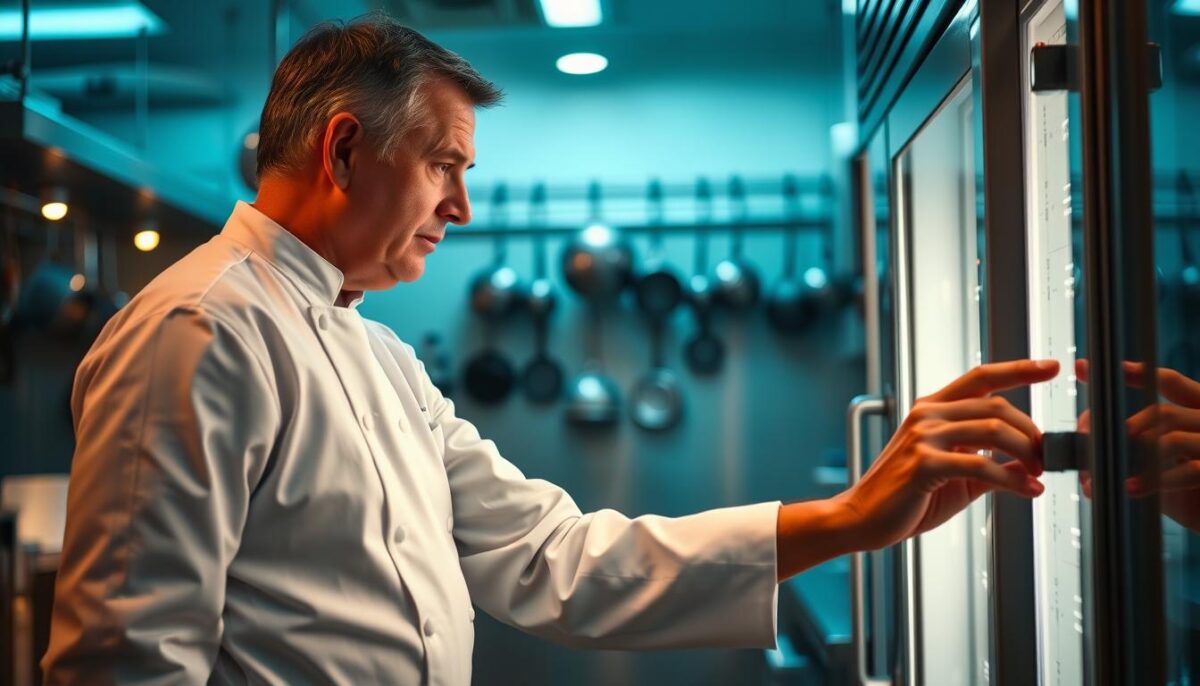
Temperature control is crucial in commercial kitchens, yet many restaurants make critical mistakes with their refrigerator and freezer temps. These mistakes can lead to food safety issues, reduced food quality, and increased energy consumption.
Mistake #1: Incorrect Temperature Settings
Many restaurants set their refrigerator and freezer temperatures incorrectly, either too warm or too cold. This can risk food safety or waste energy and potentially freeze fresh foods. For instance, if the refrigerator temperature is too warm, bacteria can multiply rapidly, compromising food safety.
Mistake #2: Ignoring Airflow Requirements
Proper airflow is critical for commercial refrigeration units. Overstocking or improper arrangement of food items can block vents and create temperature inconsistencies throughout the unit. This can lead to some areas being too cold while others are too warm, affecting food quality.
Mistake #3: Neglecting Regular Maintenance
Neglected maintenance of condenser coils, fans, and other components leads to inefficient operation, temperature fluctuations, and premature equipment failure. Regular cleaning of condenser coils, for example, can significantly improve the efficiency of the refrigeration unit.
Mistake #4: Overlooking Door Seal Integrity
Damaged or dirty door seals allow warm air to enter the refrigeration unit, making the compressor work harder and creating inconsistent temperatures. Inspecting and replacing door seals regularly can prevent this issue.
These mistakes often occur simultaneously, compounding their negative effects on food safety, quality, and equipment longevity. By identifying and addressing these issues, restaurants can improve their refrigeration systems’ efficiency and maintain high food safety standards.
Step-by-Step Solutions to Fix Temperature Issues
Resolving refrigerator and freezer temperature problems involves several key steps. To maintain optimal temperatures, it’s crucial to establish proper temperature controls, optimize airflow, implement a preventative maintenance schedule, and test door seals regularly.
Establishing Proper Temperature Controls
To ensure your refrigerator and freezer are at the right temperatures, follow these guidelines:
Ideal Temperature Ranges for Different Food Types
The ideal refrigerator temperature range is between 34-40°F. Different food types require specific temperature ranges to maintain quality and safety. For instance, raw meat and fish should be stored at the lowest temperatures, while fruits and vegetables can be stored at slightly higher temperatures.
Using Reliable Thermometers for Monitoring
Using calibrated thermometers in multiple locations within your refrigeration units is essential for accurate temperature monitoring. This helps identify any temperature fluctuations that could affect food safety.
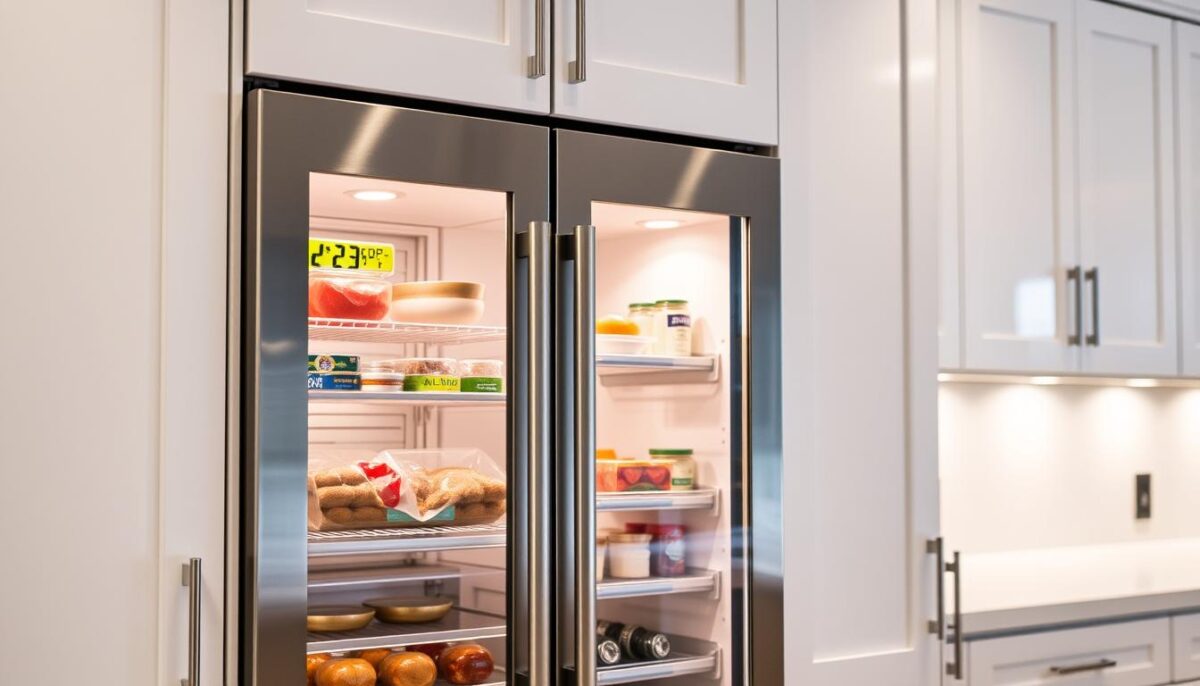
Optimizing Airflow in Commercial Refrigeration Units
Proper airflow is critical for maintaining consistent temperatures throughout your refrigerator and freezer. To optimize airflow:
Proper Food Storage Practices
Store food in a way that prevents blocking vents and allows cold air to circulate. Avoid overpacking your refrigerator and freezer, as this can restrict airflow and lead to temperature inconsistencies.
Clearing Vents and Ensuring Circulation
Regularly check and clear vents to ensure they’re not blocked by food or ice. This helps maintain proper air circulation and prevents temperature fluctuations.
| Task | Frequency | Importance |
|---|---|---|
| Check and clear vents | Weekly | High |
| Clean condenser coils | Monthly | High |
| Inspect door seals | Quarterly | High |
Implementing a Preventative Maintenance Schedule
A regular maintenance schedule helps prevent temperature issues and ensures your refrigeration equipment runs efficiently.
Cleaning Condenser Coils and Fans
Clean condenser coils by removing the plate at the bottom or back of the refrigerator. Ensure the circulation fan spins freely; if it’s blocked or damaged, it needs replacement.
Checking Defrost Systems and Components
Regularly inspect defrost systems and components to prevent ice buildup, which can affect temperature consistency and equipment performance.
Testing and Replacing Door Seals
Door seals play a crucial role in maintaining the temperature inside your refrigerator and freezer. To test door seals:
Simple Tests to Identify Leaking Seals
Place a piece of paper in the door and try to pull it out. If it comes out easily, the seals need replacement or repair.
Professional Repair vs. DIY Solutions
While some door seal repairs can be done DIY, complex issues may require professional assistance. Assess the damage and decide accordingly.
Conclusion: Maintaining Optimal Refrigeration for Restaurant Success
In conclusion, effective refrigeration management is a critical component of a successful restaurant operation. By avoiding the four common refrigerator and freezer temperature mistakes, restaurants can ensure food safety and quality, ultimately protecting their reputation and bottom line.
Implementing the solutions outlined in this guide not only addresses current issues but also prevents future problems, creating a proactive approach to refrigeration management. Regular maintenance, including cleaning condenser coils and checking door seals, is essential for optimal performance.
By prioritizing temperature control and airflow, restaurants can expect a significant return on investment, including extended equipment life and reduced energy costs. I encourage restaurant owners and managers to train their staff on the importance of proper refrigeration practices to maintain a safe and efficient kitchen environment.
By taking these steps, you can ensure your restaurant operates smoothly and maintains the highest standards of food safety and quality.
FAQ
What is the ideal temperature range for my commercial fridge?
The ideal temperature range for a commercial fridge is between 38°F and 40°F. I recommend checking your fridge’s user manual for specific guidance, as some models may vary. For instance, Sub-Zero refrigerators have precise temperature controls that allow for adjustments in small increments.
How often should I clean the condenser coils on my refrigeration unit?
I suggest cleaning the condenser coils every 3-6 months to ensure optimal airflow and prevent dust buildup. This simple maintenance task can significantly impact the performance and longevity of your refrigeration system.
Why is my ice maker not producing ice?
If your ice maker is not producing ice, it may be due to a faulty temperature sensor or ice maker assembly. Check that the temperature is set correctly and that the ice maker is turned on. I also recommend inspecting the water supply line for any kinks or blockages that might be restricting water flow.
Can I store food in the fridge at a temperature above 40°F?
No, storing food above 40°F can lead to bacterial growth and food spoilage. I always check the temperature of my fridge regularly to ensure it’s within a safe range. According to food safety guidelines, perishable items should be stored at 40°F or below to prevent contamination.
How can I improve airflow in my commercial refrigeration unit?
To improve airflow, I recommend checking that the vents are not blocked by food or other items and ensuring that the evaporator coils are clean. Proper airflow is crucial for maintaining consistent temperatures throughout the fridge or freezer.
What are the consequences of neglecting regular maintenance on my refrigeration unit?
Neglecting regular maintenance can lead to reduced performance, increased energy consumption, and even premature failure of the refrigeration unit. I make it a point to schedule regular maintenance checks to prevent these issues and ensure my equipment runs smoothly.

